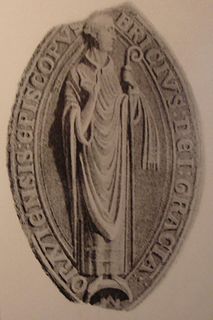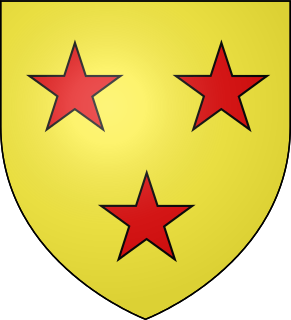
Dornoch is a town, seaside resort, parish and former royal burgh in the county of Sutherland in the Highlands of Scotland. It lies on the north shore of the Dornoch Firth, near to where it opens into the Moray Firth to the east.

Halkirk is a village on the River Thurso in Caithness, in the Highland council area of Scotland. From Halkirk the B874 road runs towards Thurso in the north and towards Georgemas in the east. The village is within the parish of Halkirk, and is said by locals to be Scotland's first planned village.

Dornoch Cathedral is a former cathedral and is now a Church of Scotland parish church serving the small Sutherland town of Dornoch, in the Scottish Highlands. As a congregation of the Church of Scotland, which is Presbyterian, the church is not the seat of a bishop but retains the name due to being, historically, the seat of the Bishop of Caithness. The Cathedral's churchyard is adjoined by Dornoch Castle, the somewhat reconstructed remains of the medieval palace of the Bishops of Caithness.

Clan Sutherland is a Highland Scottish clan whose traditional territory is the shire of Sutherland in the far north of Scotland. The chief of the clan was also the powerful Earl of Sutherland, however in the early 16th century this title passed through marriage to a younger son of the chief of Clan Gordon. The current chief is Alistair Sutherland who holds the title Earl of Sutherland.
Saint Gilbert may refer to:

The Bishop of Caithness was the ecclesiastical head of the Diocese of Caithness, one of Scotland's 13 medieval bishoprics. The first referenced bishop of Caithness was Aindréas, a Gael who appears in sources between 1146 and 1151 as bishop. Aindréas spent much if not all of his career outside his see.

Duffus is a village and parish in Moray, Scotland.

The Diocese of Moray, Ross and Caithness is one of the seven dioceses of the Scottish Episcopal Church. It covers Caithness and Sutherland, mainland Ross and Cromarty, and mainland Inverness-shire, Nairnshire, Moray and Banffshire. The diocesan centre is St Andrew's Cathedral in Inverness. The see is currently occupied by Mark Strange.
Adam of Melrose was Abbot of Melrose and Bishop of Caithness, famously burned to death by the husbandmen of Caithness. At the time, Caithness was part of the Jarldom of Orkney, which formed part of the Kingdom of Norway.

Bricius was prior of Lesmahagow and afterward bishop of Moray.

Andreas de Moravia was a 13th-century Scottish bishop. He was a younger son of Hugh de Moravia, from the family of Flemish origin who were lords of Duffus and other areas in the Greater Moray region in this period. In the time of Bishop Bricius' episcopate (1203–1222), there was a man called "Andreas" who was rector of the church of St. Peter at Duffus, and this may well have been this Andreas. He may also have been a native Scot.

Skelbo Castle is a ruined 14th century keep, located near Dornoch, Sutherland, Scotland. The remaining wall is best preserved at the northern side of the castle. The remains are protected as a scheduled monument.

Inverness Cathedral, also known as the Cathedral Church of Saint Andrew (1866–69), is a cathedral of the Scottish Episcopal Church situated in the city of Inverness in Scotland close to the banks of the River Ness. It is the seat of the Bishop of Moray, Ross and Caithness, ordinary of the Diocese of Moray, Ross and Caithness. The cathedral is the northernmost cathedral in mainland Britain and was the first new Protestant cathedral to be completed in Great Britain since the Reformation.

John de Innes was medieval Scottish churchman. Born probably in Moray, he went to France in his youth, receiving a bachelorate in civil law from the University of Paris by 1396 and in canon law by 1407. His education was partly paid for by the prebend of Duffus and a grant from Alexander Bur, Bishop of Moray, taken by Bur from the judicial profits of his diocese. During Innes' study period, he was also pursuing an ecclesiastical career, being Archdeacon of Caithness from 1396 until 1398, and Dean of Ross, from some point between 1396 and 1398 until 1407.

The Murrays of Aberscross were a minor noble Scottish family who were seated at Aberscross Castle, in the county of Sutherland, Scotland. The Murrays in Sutherland are recorded specifically as a clan in two Acts of the Scottish Parliament of the 16th century.

The Battle of Torran-Roy was a Scottish clan battle that took place in the year 1570 in the county of Sutherland, Scotland. It was fought between the forces of Alexander Gordon, 12th Earl of Sutherland and the forces of George Sinclair, 4th Earl of Caithness. The Earl of Sutherland's force consisted primarily of the Murrays of Aberscross who despite their name were not part of the Clan Murray in Atholl, but who were a sept of the Clan Sutherland, and who as the principal vassals of the Earl of Sutherland, were charged with the defense of the shire. The Earl of Caithness's forces consisted primarily of followers of the Sutherland Laird of Duffus who was a descendant of the old de Moravia/Sutherland Earls of Sutherland who had been ousted and replaced by the Gordons as earls in the early 16th-century.

Richard de Moravia or Richard de Moray of Culbin or of Cubyn, was a Scottish nobleman famed for his victory over the Vikings at the Battle of Embo which took place in Sutherland, Scotland in 1245.

The Battle of Embo was a battle that took place at Embo in Sutherland, Scotland in 1245. It was fought by Scottish forces against Viking invaders who were defeated.

William de Moravia was a Scottish nobleman, Earl of Sutherland and chief of the Clan Sutherland, a Scottish clan of the Scottish Highlands.

William de Moravia, was a Scottish nobleman, 2nd Earl of Sutherland and chief of the Clan Sutherland, a Scottish clan of the Scottish Highlands.
















